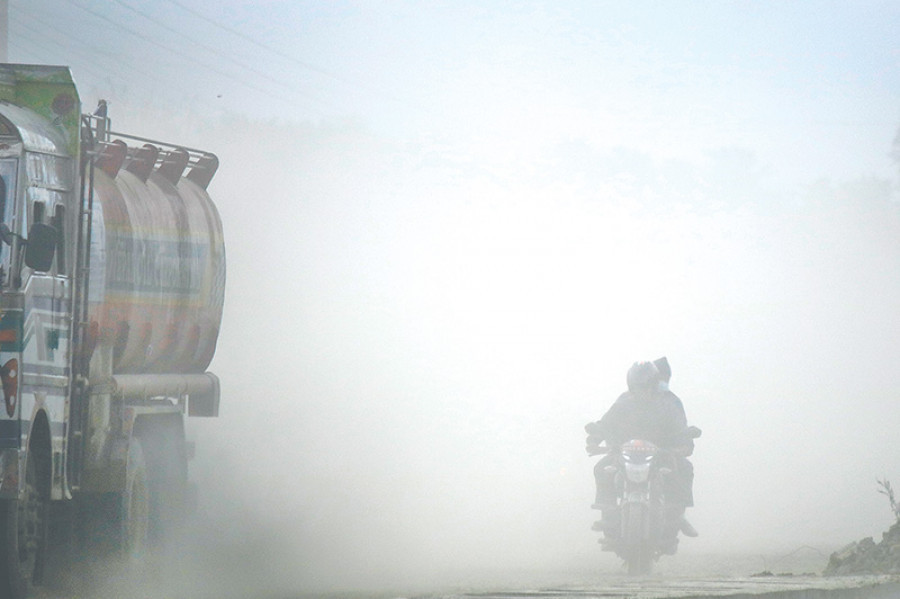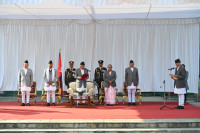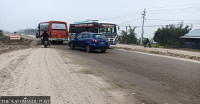National
Local leaders of Kathmandu Valley seek cooperation to fight air pollution
Federal government also needs to do its bit to clean the air, especially in cities, they argue.
Chandan Kumar Mandal
As polluted air blankets Kathmandu Valley and other major cities across the country with dipping temperatures, local government representatives, public health officials and environmentalists have stressed the need for a collaboration among local governments in the Valley to tackle air pollution.
Every year as the winter sets in, Kathmandu and other municipalities in the Valley experience deteriorated levels of air quality—even exceeding the World Health Organization’s Air Quality standards. But residents of the Valley continue to breathe in toxic air, which can have detrimental effects on human health.
During a virtual interaction among stakeholders on Thursday, local government leaders pointed out the need to work together to improve the quality of air in the city.
“We have been facing air pollution as one of the major urban problems for years. The general public in the Capital and neighbouring municipalities are dealing with this issue, which has gotten more severe than in other parts of the world,” said Ashok Byanju, mayor of Dhulikhel Municipality.
“As air pollution levels continue to go up in the Valley, the responsibility of fighting against hazardous air rests on local governments—as enshrined in the constitution. But we have been unable to work together so far.”
Byanju, also the president of the Municipal Association of Nepal, an organisation of mayors and chairmen of municipalities across Nepal, added that Kathmandu and other cities in the Valley can be transformed into clean cities only if all local governments come together against the public health hazard.
“Local governments have been focusing on building roads and other infrastructure, but we have to pay attention to making our cities clean as well. Cities such as Bhaktapur can be an example for us to follow.”
Emissions from fossil fuel-operated vehicles and brick kilns, dust from roads and other construction sites and open burning of waste are the major sources of air pollution in Kathmandu Valley.
The air quality in the Valley worsens to unhealthy levels every year during winter every year due to thermal inversion as pollutants remain suspended in the air for a long time.
Despite hue and cry from the general public and environmentalists, air pollution remains a major public health concern for the Kathmandu Valley. The capital city and the country are often dubbed as one of the most polluted places in the world.
Last month, the State of Global Air report 2020 placed Nepal among the top 10 countries with the highest outdoor PM2.5 levels in 2019. With an annual average of 83.1 micrograms per cubic meter (μg/m3) of PM2.5 in the country, Nepal was adjudged the second most polluted country in the world. According to the report, an estimated 42,100 deaths were attributed to air pollution in the country.
In a bid to deal with the unsafe air quality of the Kathmandu Valley, the government has endorsed Kathmandu Valley’s Air Pollution Management Action Plan. Participants of the interaction called for effective enforcement of the plan to improve air quality.
“We have devised several management plans in the past as well. But we have not strictly enforced them,” said Sunil Prajapati, mayor of Bhaktapur. “If we want to make Kathmandu Valley a beautiful and clean city with safe air, then we must work together through the integrated plans and dividing responsibility among all the local levels.”
The air pollution management action plan identified 11 strategic sectors for improving the Valley’s air quality.
“Out of the 136 activities proposed to achieve the goal of clean and healthy air, 75 activities—42 in main roles and 32 collaborative roles—are directly linked to local governments,” said Indu Bikram Joshi, deputy director-general of Department of Environment. “Allocation of such massive responsibilities to local governments show the role they can play in curbing air pollution,” said Joshi, who was also a key member of the action plan drafting committee.
Local government representatives also sought initiatives from the federal government to fight poor air quality by allocating funds from the pollution tax the government collects from the sale of the petroleum products. Billions of rupees collected over the years, however, remains unspent.
“Every other development activity leads to some sort of air pollution. Therefore, all levels of government should come up with environmental management plans along with their development activities. The central government should take the lead in this regard,” said Rameshor Shrestha, mayor of Mahalaxmi Municipality in Lalitpur. “Not only local units of the Kathmandu Valley, but also adjoining local units have to work for achieving healthy and clean air.”
Bina Bastola, deputy mayor of Changunarayan Municipality, said her locality receives hazardous air from other parts of the Valley, and also there are 52 brick kilns operating in the municipality.
“One can only imagine the level of pollution from these brick kilns and more toxic air coming from other parts of the Valley,” said Bastola. “But our local government can’t do anything in the case of brick kilns as their licences are issued by the federal government.”
Environmentalists and public health officials also highlighted the need for dealing with air pollution urgently at the time the country is already reeling under the Covid-19 pandemic. Poor air quality coupled with Covid-19 can deal a double blow to the country.
Studies have shown links between air pollution to higher Covid-19 mortality. Those with heart and lung ailments, which could be also because of air pollution, are at a higher risk of coronavirus infection and death.
There have already been growing concerns that air pollution exposures, especially in the most polluted regions of South Asia, could exacerbate the effects of Covid-19 significantly.
“Recent studies have shown that places with higher air pollution can also have 15 percent more cases of Covid-19 cases,” said Prof Dr Sanjay Nath Khanal at the Department of Environmental Science and Engineering at Kathmandu University.
“The air quality in winter worsens nearly five times more than in the rainy season. Among many measures for improving air quality, local governments can start by enforcing the action plan, banning open waste burning, taking highly polluting vehicles off the road and promoting walking and cycling culture.”




 7.12°C Kathmandu
7.12°C Kathmandu















